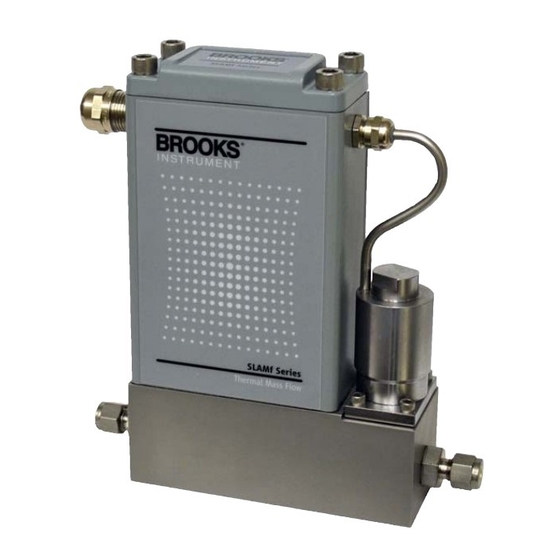
Summarization of Contents
Before Starting
Background & Assumptions
Manual assumes familiarity with SLA5800/SLAMf theory and DeviceNet basics.
Compliance
Device conforms to ODVA standards, certified by ODVA.
Notations
Details notations and conventions used, including hex/binary numbers and EPATH format.
Quick Start
Step 1: Set Baud Rate and MAC ID
Guide to setting device communication parameters using switches for Baud Rate and MAC ID.
Step 2: Configure Scanner
Information needed to configure the scanning device for the PC.
Step 3: Plumb to the Device
Instructions for connecting gas flow paths to the device.
Step 4: Connect Device to the Network
Steps to connect the device to the DeviceNet network using the M12 connector.
Step 5: Apply Power to the Network
Guidance on ensuring proper +24 VDC power supply for the DeviceNet network.
Step 6: LED Verification
Procedure to verify network and module status using LEDs.
Step 7: Begin Scanning the Network
Instructions to enable the scanner to start polling the device.
Step 7: Normal Operation
Describes device states (Idle/Executing) and how to transition between them.
Configuration
I/O Assemblies
Explains how Assemblies define data exchange between Master and device in I/O connections.
The “Inferred” Data Type
Discusses dynamic data types and their interaction with Assembly instances.
Data Type
Defines how data is represented and transmitted, supporting INT and REAL types.
Data Units
Explains how to report pressure and accept setpoints in engineering units.
Safe State (i.e. Safe Mode)
Describes device behavior when entering a safe operational state, ignoring inputs.
Valve Safe Mode
Defines safe states for the valve, specifying its behavior in safe mode.
Pressure Sensor Safe Mode
Defines safe states for the pressure sensor, specifying its behavior in safe mode.
Pressure Applications Selection
How to configure pressure applications via "Pressure Application Instance" attribute.
Pressure Sensor Group
Lists parameters for configuring the pressure sensor, including data type and units.
Pressure Sensor Safe State Values
Outlines valid safe states for the pressure sensor, defining its behavior in safe mode.
Valve Group
Covers parameters for configuring valve behavior, including data type and safe states.
Valve Safe State Values
Outlines valid safe states for the valve, specifying its behavior in safe mode.
Valve Override
Defines valid actuator override types, allowing direct control commands.
Pressure Control Group
Details parameters for pressure control, including PID gains and ramp rate.
Polled Connection Group
Parameters for selecting I/O assemblies for Polled I/O connections.
Device Info Group
Lists read-only parameters providing device identification and revision information.
Soft Start (Ramp) Control Group
Configuration for the soft-start (ramping) feature of the device.
PID Control Group
Parameters for tuning PID control loop performance.
Alarms/Warnings Group
Enables/disables reporting of device alarms and warnings.
Detailed Configuration
Identity Object [0x1]
Contains informational attributes that uniquely describe the device, like Vendor ID and Serial Number.
Message Router Object [0x2]
Tracks accessibility of Classes and Instances, routing explicit messages.
DeviceNet Object [0x3]
Manages DeviceNet communications interface, MAC ID, Baud Rate, and connections.
Assembly Object [0x4]
Lists attributes for data transfer via Data Buffer, used as I/O Connection endpoints.
Connection Object [0x5]
Configures characteristics and behavior of logical connections, including explicit and I/O types.
S-Device Supervisor Object [0x30]
Oversees device operation and status, managing state machines for sensors, actuators, and controllers.
S-Analog Sensor Object [0x31]
Responsible for reporting sensor values, linearizing data, and converting to engineering units.
S-Analog Actuator Object [0x32]
Manages the actuator device controlling the process, handling override and safe states.
S-Single Stage Controller Object [0x33]
Closes the control loop by managing the process variable and control variable.
Appendix
Appendix A - Assembly Object Detail
Details Assembly Objects supported by the PC, defining Input/Output relative to the network.
Appendix B - Data Type Definitions
Lists DeviceNet data types used in the manual and their C/C++ encoding.
Appendix C – Data Units
Provides tables of pressure and actuator units with their corresponding codes.
Appendix D - LED Flash Codes
Explains NET and MOD LED indications for network and device status.
Appendix E - Service Summary and Details
Summarizes service parameters for Get/Set Attribute Single services.
Appendix F - State
Illustrates device state transitions with a State Machine Diagram.
Appendix G - EDS Parameter Configuration
Describes parameters defined in the EDS file, grouped by category.
















Need help?
Do you have a question about the SLA5800 Series and is the answer not in the manual?
Questions and answers